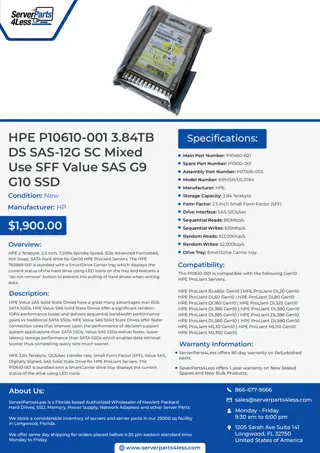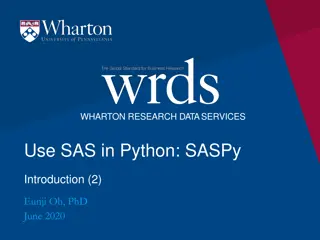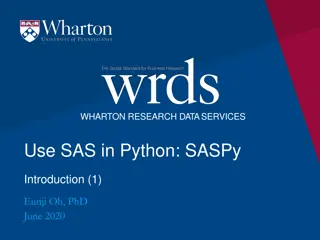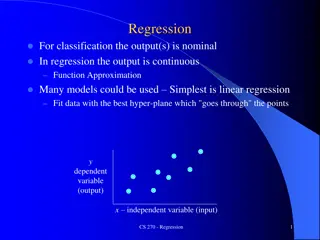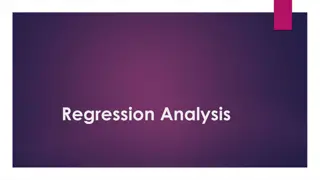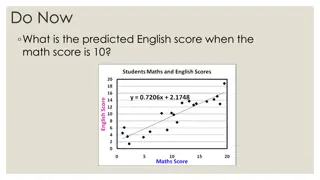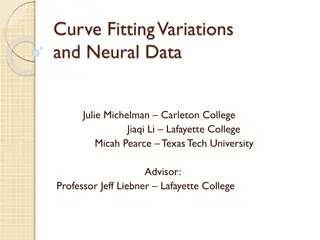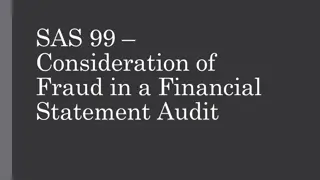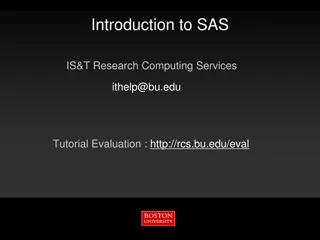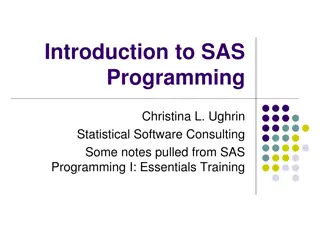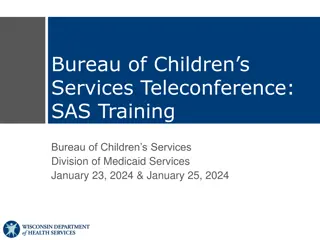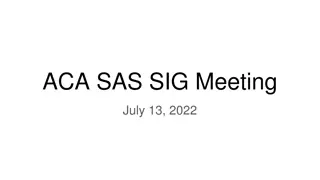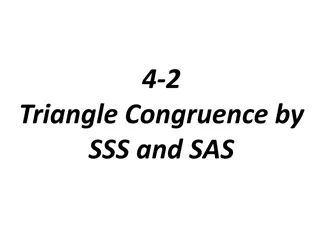Understanding Overdispersed Data in SAS for Regression Analysis
Explore the concept of overdispersion in count and binary data, its causes, consequences, and how to account for it in regression analysis using SAS. Learn about Poisson and binomial distributions, along with common techniques like Poisson regression and logistic regression. Gain insights into handling extra variation in your data for more accurate statistical modeling.
Uploaded on Sep 07, 2024 | 0 Views
Download Presentation

Please find below an Image/Link to download the presentation.
The content on the website is provided AS IS for your information and personal use only. It may not be sold, licensed, or shared on other websites without obtaining consent from the author. Download presentation by click this link. If you encounter any issues during the download, it is possible that the publisher has removed the file from their server.
E N D
Presentation Transcript
Analysis of Overdispersed Data in SAS Jessica Harwood, M.S. Statistician, Center for Community Health JHarwood@mednet.ucla.edu
Outline - Overdispersion Definition, background, and causes of overdispersion Consequences of ignoring overdispersion Accounting for overdispersion in regression analysis in SAS For count data For binary data Concluding remarks 2 Jessica Harwood CHIPTS Methods Seminar 1/8/2013
Overdispersed data Also known as extra variation Arises when count or binary data exhibit variances larger than those assumed under the Poisson or binomial distributions 3 Jessica Harwood CHIPTS Methods Seminar 1/8/2013
Count data Definition: non-negative integer values {0, 1, 2, 3, ...} arising from counting rather than ranking Example: the number of days a student is absent in one school year Commonly analyzed using Poisson distribution, e.g., Poisson regression 4 Jessica Harwood CHIPTS Methods Seminar 1/8/2013
Poisson Distribution Poisson: number of occurrences of a random event in an interval of time or space. Poisson regression IRR (relative risk) Natural model for count data Disadvantage - strong assumption: variance = mean Overdispersion: variance > mean 5 Jessica Harwood CHIPTS Methods Seminar 1/8/2013
Binary Data Binary: 0 or 1 Example: ever tested for HIV (1) or not (0) Grouped binary Example: proportion tested for HIV Binary: tested_HIV Grouped: num_tested_HIV/num_subjects city tested_HIV Subject 1 1 1 1 1 2 1 0 3 1 0 4 2 1 1 2 0 2 2 0 3 city 1 2 num_tested_HIV num_subjects 2 1 4 3 Commonly analyzed using binomial distribution, e.g., logistic regression 6 Jessica Harwood CHIPTS Methods Seminar 1/8/2013
Binomial distribution Binomial: the number of successes in a sequence of random processes that results in one of two mutually exclusive outcomes Overdispersion: variance larger than that assumed under the binomial distribution 7 Jessica Harwood CHIPTS Methods Seminar 1/8/2013
Causes of Overdispersion Observed data rarely follow statistical distributions exactly The variance of count variables tends to increase with the size of the counts Correlated (ex: clustered) data Heterogeneity among observations Large number of 0 s 8 Jessica Harwood CHIPTS Methods Seminar 1/8/2013
Consequences of Ignoring Overdispersion Overdispersion (observed variance larger than that assumed by model) Standard Errors Underestimated P-Values Underestimated (insignificant associations appear significant) Type I Error Inflated (higher false positive rates) Erroneous Inference 9 Jessica Harwood CHIPTS Methods Seminar 1/8/2013
Checking for Overdispersion in SAS Count Data PROC MEANS variance > mean? PROC GENMOD dist=negbin dispersion parameter significant? 10 Jessica Harwood CHIPTS Methods Seminar 1/8/2013
Example Count Data Differences in baseline depression between intervention conditions in a RCT Independent variable: INTV - intervention condition 1 = Randomized to intervention condition 0 = Randomized to control condition Dependent variable: EPDS - Edinburgh Postnatal Depression Scale; weighted count of depressive symptoms felt in past week 11 Jessica Harwood CHIPTS Methods Seminar 1/8/2013
Example Count Data HISTOGRAM OF EPDS 14 12 10 8 Percent 6 4 2 0 EPDS Score (range 0-30) 12 Jessica Harwood CHIPTS Methods Seminar 1/8/2013
Example Count Data Check mean and variance for overdispersion _____SAS Code SAS Output_____ *Mean and variance; procmeans data=base mean var; var EPDS; run; Analysis Variable : EPDS Mean Variance 11.17 47.34 *Conditional mean and variance; procmeans data=base mean var; var EPDS; class INTV; run; Analysis Variable : EPDS INTV N Obs Mean Variance 11.35 48.31 0 533 11.01 46.52 1 611 13 Jessica Harwood CHIPTS Methods Seminar 1/8/2013
Example Count Data SAS regression analysis *Poisson regression ignore overdispersion; procgenmod data = base; model EPDS = INTV / dist=poisson; run; *Negative binomial regression account for overdispersion; procgenmod data = base; model EPDS = INTV / dist=negbin; run; 14 Jessica Harwood CHIPTS Methods Seminar 1/8/2013
Example Count Data Check for overdispersion: negative binomial regression in PROC GENMOD Dispersion parameter significantly different from zero (see 95% CI): Indicates significant over- (> 0) or under- (< 0) dispersion Use negative binomial rather than Poisson Negative binomial regression- account for overdispersion Analysis Of Maximum Likelihood Parameter Estimates Parameter DF Estimate Standard Wald 95% Confidence Limits 2.0306 -0.227 0.9185 Wald Chi- Square 1973.7 <.0001 2.18 0.1394 Pr > ChiSq Error 1 1 1 2.1244 -0.0974 1.0192 0.0478 0.0659 0.0514 2.2181 0.0318 1.1198 Intercept INTV Dispersion 15 Jessica Harwood CHIPTS Methods Seminar 1/8/2013
Example Count Data Results P-values quite different Different conclusions regarding similarity of intervention conditions at baseline EPDS: Poisson regression- ignore overdispersion Analysis Of Maximum Likelihood Parameter Estimates Parameter DF Estimate Standard Wald 95% Confidence Limits 2.094 -0.14 1 Wald Chi- Square 18805 <.0001 19.95 <.0001 Pr > ChiSq Error 1 1 0 2.1244 -0.0974 0.0155 0.0218 2.1547 -0.055 Intercept INTV Scale EPDS: Negative binomial regression- account for overdispersion Analysis Of Maximum Likelihood Parameter Estimates Parameter DF Estimate Standard 1 0 1 Wald 95% Confidence Limits 2.0306 -0.227 0.9185 Wald Chi- Square 1973.7 <.0001 2.18 0.1394 Pr > ChiSq Error 1 1 1 2.1244 -0.0974 1.0192 0.0478 0.0659 0.0514 2.2181 0.0318 1.1198 Intercept INTV Dispersion 16 Jessica Harwood CHIPTS Methods Seminar 1/8/2013
Accounting for overdispersion in SAS: count data Negative binomial Variance-adjustment models Quasi-likelihood Estimation Empirical (aka robust, sandwich) variance estimation Models for correlated data Zero-inflated models 17 Jessica Harwood CHIPTS Methods Seminar 1/8/2013
Negative binomial (NB) Negative binomial distribution: variance is larger than the mean excellent model for overdispersed count data Negative binomial regression relative risk Disadvantage: estimating extra parameter (dispersion) PROC GENMOD PROC COUNTREG 18 Jessica Harwood CHIPTS Methods Seminar 1/8/2013
SAS code: negative binomial regression procgenmod data = base; model EPDS = INTV / dist=negbin; run; proccountreg data = base; model EPDS = INTV / dist=negbin; run; 19 Jessica Harwood CHIPTS Methods Seminar 1/8/2013
SAS output: negative binomial regression PROC GENMOD Analysis Of Maximum Likelihood Parameter Estimates Parameter DF Estimate Standard Error Wald 95% Confidence Limits Wald Chi- Square 1973.73 <.0001 2.18 0.1394 Pr > ChiSq 1 1 1 2.1244 -0.0974 1.0192 0.0478 2.0306 2.2181 0.0659-0.2265 0.0318 0.0514 0.9185 1.1198 Intercept INTV Dispersion PROC COUNTREG Parameter Estimates Parameter DF Estimate Standard t Value Approx Error Pr > |t| 1 1 1 2.1244 -0.0974 1.0192 0.0478 0.0659 0.0514 44.43 <.0001 -1.48 0.1394 19.84 <.0001 Intercept INTV _Alpha Compare to Poisson regression: INTV: Estimate=-0.0974; SE=0.0218;P<.0001 20 Jessica Harwood CHIPTS Methods Seminar 1/8/2013
SAS output: negative binomial regression NB: Variance > mean Variance = mean + k *mean SAS estimate of dispersion parameter k: Dispersion , _Alpha If k significantly different from zero use NB rather than Poisson 2 PROC GENMOD Analysis Of Maximum Likelihood Parameter Estimates Parameter DF Estimate Standard Error Wald 95% Confidence Limits Wald Chi- Square Pr > ChiSq 1 1 1 2.1244 -0.0974 1.0192 0.0478 2.0306 2.2181 0.0659 -0.2265 0.0318 0.0514 0.9185 1.1198 1973.73 <.0001 2.18 0.1394 Intercept INTV Dispersion PROC COUNTREG Parameter Estimates Estimate Standard Parameter DF t Value Approx Error Pr > |t| <.0001 0.1394 <.0001 1 1 1 2.1244 -0.0974 1.0192 0.0478 0.0659 0.0514 44.43 -1.48 19.84 Intercept INTV _Alpha 21 Jessica Harwood CHIPTS Methods Seminar 1/8/2013
Count data: Quasi-likelihood Estimation (QLE) QLE allows for adjusting variance without specifying distribution exactly Variances inflated by Deviance/DOF (GENMOD: dscale ) Pearson s Chi-Square/DOF GENMOD: pscale GLIMMIX: random _residual_ Poisson and negative binomial regression (and logistic regression) 22 Jessica Harwood CHIPTS Methods Seminar 1/8/2013
QLE Example - SAS Code Use dscale as the norm! *Poisson regression- no adjustment for overdispersion; procgenmod data=base; model EPDS = INTV/ dist=poisson; run; *Poisson regression- adjust for overdispersion using DSCALE ; procgenmod data=base; model EPDS = INTV/ dist=poisson dscale; run; 23 Jessica Harwood CHIPTS Methods Seminar 1/8/2013
QLE- standard errors (SE) corrected Poisson - unadjusted variances Criteria For Assessing Goodness Of Fit Criterion DF Value Deviance 1056 7783.18 Analysis Of Maximum Likelihood Parameter Estimates Value/DF 7.3704 Parameter DF Estimate Standard Wald 95% Confidence Limits Wald Chi- Square 18805 <.0001 19.95 <.0001 Pr > ChiSq Error 1 1 0 2.1244 -0.0974 0.0155 0.0218 -0.1 -0.055 0 2.1 2.155 Intercept INTV Scale Note: The scale parameter was held fixed. 1 1 1 Poisson-QLE using "DSCALE" - SE inflated by the square root of Deviance/DOF Criteria For Assessing Goodness Of Fit Criterion DF Value Value/DF Deviance 1056 7783.18 7.3704 Analysis Of Maximum Likelihood Parameter Estimates = 7.3704 = 2.7148 Parameter DF Estimate Standard Wald 95% Confidence Limits Wald Chi- Square 2551.4 <.0001 2.71 0.0999 Pr > ChiSq Error 1 1 0 2.1244 -0.0974 2.7149 0.0421 0.0592 -0.2 0 2 2.207 0.019 2.715 Intercept INTV Scale Note: The scale parameter was estimated by the square root of DEVIANCE/DOF. 2.7 24 Jessica Harwood CHIPTS Methods Seminar 1/8/2013
QLE- Poisson vs. NB Poisson - unadjusted variances Criteria For Assessing Goodness Of Fit Criterion DF Deviance 1056 7783.177 Analysis Of Maximum Likelihood Parameter Negative binomial - unadjusted variances Criteria For Assessing Goodness Of Fit Criterion DF Value Deviance 1056 1220.558 Analysis Of Maximum Likelihood Parameter Value Value/DF 7.3704 Value/DF 1.1558 Parameter INTV DF Estimate -0.0974 SE 0.0218 <.0001 P-Val Parameter INTV DF Estimate -0.0974 SE 0.0659 P-Val 0.1394 1 1 Poisson-QLE using "DSCALE" - SE inflated by the square root of Deviance/DOF = 7.3704 = 2.7148 Criteria For Assessing Goodness Of Fit Criterion DF Value Deviance 1056 7783.177 Analysis Of Maximum Likelihood Parameter NB -QLE using "DSCALE" - SE inflated by the square root of Deviance/DOF = 1.1558 = 1.0751 Criteria For Assessing Goodness Of Fit Criterion DF Value Deviance 1056 1220.558 Analysis Of Maximum Likelihood Parameter Value/DF 7.3704 Value/DF 1.1558 Parameter INTV Note: The scale parameter was estimated by the square root of DEVIANCE/DOF. DF Estimate -0.0974 SE 0.0592 P-Val 0.0999 Parameter INTV Note: The covariance matrix was multiplied by a factor of DEVIANCE/DOF. DF Estimate -0.0974 SE 0.0708 P-Val 0.1692 1 1 25 Jessica Harwood CHIPTS Methods Seminar 1/8/2013
QLE PSCALE- SAS Code procgenmod data=base; model EPSD=INTV / dist=poisson pscale; run; Criterion Pearson Chi-Square Analysis Of Maximum Likelihood Parameter Estimates Criteria For Assessing Goodness Of Fit DF Value 7752.096 Value/DF 1056 7.341 Standard Error 0.0420 0.0591 0 Wald 95% Confidence Limits 2.0421 -0.2131 2.7094 Wald Chi- Square 2561.66 2.72 Parameter Intercept INTV Scale Note: The scale parameter was estimated by the square root of Pearson's Chi-Square/DOF. DF 1 1 0 Estimate 2.1244 -0.0974 2.7094 Pr > ChiSq <.0001 0.0992 2.2066 0.0184 2.7094 procglimmix data=base; model EPSD=INTV / dist=poisson s; random _residual_; run; Fit Statistics Pearson Chi-Square Pearson Chi-Square / DF 7752 7.34 Parameter Estimates Standard Error 2.1244 0.0420 -0.0974 0.0591 7.341 Effect Intercept INTV Residual Estimate DF 1056 1056 . t Value Pr > |t| 50.61 -1.65 . <.0001 0.0995 . . 26 Jessica Harwood CHIPTS Methods Seminar 1/8/2013
Count Data QLE In Sum Use as the norm, in Poisson or NB DSCALE better than PSCALE, especially for low counts 27 Jessica Harwood CHIPTS Methods Seminar 1/8/2013
Count Data: Empirical Variance Estimation Empirical (or robust or sandwich) variance estimation account for extra variation by using both empirical-based estimates and model-based estimates in variance estimation Poisson and NB regression (and logistic regression) GENMOD: REPEATED statement GLIMMIX: EMPIRICAL option 28 Jessica Harwood CHIPTS Methods Seminar 1/8/2013
Empirical Variance Estimation GENMOD REPEATED *PID = Participant ID , 1 observation per PID; procgenmod data=base; class PID; model EPDS=INTV / dist=poisson; repeated subject = PID; run; Analysis Of GEE Parameter Estimates Empirical Standard Error Estimates Parameter Estimate Standard Error Intercept 2.1244 0.0415 2.0431 INTV -0.0974 95% Confidence Limits Z Pr > |Z| 2.2056 0.0182 51.25<.0001 -1.65 0.0986 0.059 -0.2129 Compare to unadjusted Poisson regression: INTV: Estimate=-0.0974; SE=0.0218;P<.0001 29 Jessica Harwood CHIPTS Methods Seminar 1/8/2013
Empirical Variance Estimation GLIMMIX EMPIRICAL *PID = Participant ID 1 observation per PID. MBN is small-sample bias correction; procglimmix data=base empirical=mbn; class PID; model EPDS=INTV / dist=poisson s; random _residual_ /subject = PID; run; Effect Estimate Standard Solutions for Fixed Effects DF t Value Pr > |t| Error 0.04153 0.05907 2.1244 -0.09738 1056 1056 51.16<.0001 -1.65 0.0995 Intercept INTV 30 Jessica Harwood CHIPTS Methods Seminar 1/8/2013
Count Data: Correlated (ex: clustered) data Longitudinal data (clustering of repeated measurements within subjects) Nested data (clustering of multiple subjects within groups) Poisson, NB, or logistic regression 31 Jessica Harwood CHIPTS Methods Seminar 1/8/2013
Count Data: Correlated (ex: clustered) data Generalized Linear Mixed Models (GLMM) GLIMMIX RANDOM INT [Conditional model, subject-specific inference] GLIMMIX RANDOM _RESIDUAL_ [Marginal model, inference on population averages] Generalized Estimating Equations (GEE) [Marginal model] GENMOD REPEATED Small-sample bias correction in GLIMMIX with EMPIRICAL=mbn option 32 Jessica Harwood CHIPTS Methods Seminar 1/8/2013
Clustered Data GLMM *Participants clustered by city. Marginal model; procglimmix data=base; class city; model EPDS=INTV / dist=nb s; random _residual_ / subject=city type=cs; run; *Participants clustered by city. Conditional model; procglimmix data=base; class city; model EPDS=INTV / dist=nb s; random int /subject=city; run; 33 Jessica Harwood CHIPTS Methods Seminar 1/8/2013
Clustered Data GEE *Participants clustered by city. MBN is small-sample bias correction; procglimmix data=base empirical=mbn; class city; model EPDS=INTV / dist=nb s; random _residual_ /subject =city; run; procgenmod data=base; class city; model EPDS=INTV / dist=nb; repeated subject = city / type=cs; run; 34 Jessica Harwood CHIPTS Methods Seminar 1/8/2013
Count Data - Zero-Inflated (ZI) Models ZI models appropriate when variable contains an excess of zero values- sample heterogeneity Assume sample contains two different populations: nonsusceptible (always zero) subjects and susceptible (not always zero) subjects ZI regression - two regression models (each with own explanatory variables): Logit or probit regression - model the probability of being nonsusceptible Poisson/NB/logistic regression - model the mean for the susceptible population 35 Jessica Harwood CHIPTS Methods Seminar 1/8/2013
Count data - ZI in SAS PROC GENMOD PROC COUNTREG Zero-inflated Poisson: dist=ZIP Zero-inflated NB: dist=ZINB Even after accounting for excess zeros, NB may fit the remaining counts better than Poisson GENMOD ZINB: SAS version > 9.2 36 Jessica Harwood CHIPTS Methods Seminar 1/8/2013
Example - ZI Variable of interest - count: number of fish caught by groups of campers at a national park Explanatory variables: Number of children in the group (child) Whether or not the group brought a camper to the park (camper) Number of people in the group (persons) 37 Jessica Harwood CHIPTS Methods Seminar 1/8/2013
57% of values are zero values 38 Jessica Harwood CHIPTS Methods Seminar 1/8/2013
Example ZI SAS Code procgenmod data = m.fish; model count = child camper /dist=zip; zeromodel persons /link = logit ; run; proccountreg data = m.fish method = qn; model count = child camper / dist=zip; zeromodel count ~ persons; run; 39 Jessica Harwood CHIPTS Methods Seminar 1/8/2013
Example ZI SAS Output GENMOD Analysis Of Maximum Likelihood Parameter Estimates DF Estimate Standard Error Parameter Wald 95% Confidence Limits 1.4302 -1.239 0.6505 1 Wald Chi- Square 348.96<.0001 108.78<.0001 79.35<.0001 Pr > Chi Sq 1 1 1 0 1.5979 -1.0428 0.834 0.0855 1.7655 -0.847 1.0175 Intercept child camper Scale Analysis Of Maximum Likelihood Zero Inflation Parameter Estimates Parameter DF Estimate Standard 0.1 0.0936 1 0 1 Wald 95% Confidence Limits 0.5647 -0.884 Wald Chi- Square 12.04 11.99 Pr > Chi Sq Error 1 1 1.2974 -0.5643 0.3739 0.163 2.0302 -0.245 0.0005 0.0005 Intercept persons COUNTREG Parameter Estimates DF Estimate Standard Parameter t Value Approx Error Pr > |t| 1 1 1 1 1 1.59789 -1.04284 0.83402 1.29744 -0.56435 0.08554 0.09999 0.09363 0.37385 0.16296 18.68<.0001 -10.43<.0001 8.91<.0001 3.47 -3.46 Intercept child camper Inf_Intercept Inf_persons 0.0005 0.0005 40 Jessica Harwood CHIPTS Methods Seminar 1/8/2013
Accounting for overdispersion in SAS: binary data Random-clumped binomial and beta- binomial models Zero-inflated binomial (ZIB) Variance-adjustment models Quasi-likelihood Estimation Empirical (aka robust, sandwich) variance estimation Models for correlated data 41 Jessica Harwood CHIPTS Methods Seminar 1/8/2013
Binary Data BB and RCB Beta-binomial (BB) and random-clumped binomial (RCB) Model physical mechanism behind overdispersion PROC NLMIXED SAS 9.3 PROC FMM (experimental) 42 Jessica Harwood CHIPTS Methods Seminar 1/8/2013
43 Jessica Harwood CHIPTS Methods Seminar 1/8/2013
Example BB and RCB . . . n=1 337 n=337 nuclei Each nucleus has m=3 total number of chromosome pairs t: number of chromosome pairs with association at meiosis (t=0, 1, 2, 3) If probability of association at meiosis (t/m) is constant for all nuclei and the same for all chromosome pairs, then binomial distribution appropriate If not RCB or BB 44 Jessica Harwood CHIPTS Methods Seminar 1/8/2013
Example BB and RCB Data 45 Jessica Harwood CHIPTS Methods Seminar 1/8/2013
BB and RCB PROC NLMIXED 46 Jessica Harwood CHIPTS Methods Seminar 1/8/2013
Binary data: ZIB ZI model simultaneously model the probability of being always zero and the probability of the event of interest conditional on being in the not always zero population 47 Jessica Harwood CHIPTS Methods Seminar 1/8/2013
Binary Data - QLE - Example Cases of toxoplasmosis in 34 cities in El Salvador tox: 1=toxoplasmosis case, 0=no toxoplasmosis rain: annual rainfall (cm) Binary: tox Grouped: num_tox/num_total city tox Subject 1 1 1 1 1 2 1 0 3 1 0 4 2 1 1 2 0 2 2 0 3 city 1 2 num_tox 2 1 num_total 4 3 48 Jessica Harwood CHIPTS Methods Seminar 1/8/2013
QLE SAS Code *Grouped binary (1 observation for each city); procgenmod data=tox; model num_tox/num_total = rain | rain | rain/ dist=bin dscale; run; *Binary multiple observations per city; procgenmod data=test desc; model tox = rain | rain | rain/ dist=bin dscale aggregate=city; run; 49 Jessica Harwood CHIPTS Methods Seminar 1/8/2013
QLE SAS Output Analysis Of Maximum Likelihood Parameter Estimates Parameter DF Estimate Standard Error Wald 95% Confidence Limits Wald Chi- Square Pr > Ch iSq 1 1 1 1 0 0.0994 -0.449 -0.187 0.2134 1.4449 0.1473 -0.189 0.3882 0.2242 -0.888 -0.009 0.1322 -0.447 0.0719 0.092 0.033 0.3938 01.4449 1.4449 0.46 0.4999 4 0.0454 2.01 0.1568 5.38 0.0204 Intercept rain rain*rain rain*rain*rain Scale Note: The scale parameter was estimated by the square root of DEVIANCE/DOF. 50 Jessica Harwood CHIPTS Methods Seminar 1/8/2013


